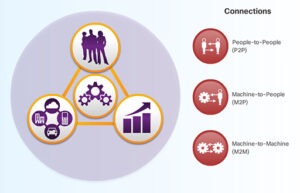Unveiling the Mystery of Quantum Computing: A Beginner’s Guide
Introduction
In the vast landscape of technology, one term that has been making waves is “quantum computing.” It’s a phrase that sparks curiosity and fascination among both tech enthusiasts and novices alike. But what exactly is quantum computing? How does it work, and why is it considered revolutionary? In this comprehensive guide, we’ll embark on a journey to demystify the complex world of quantum computing, breaking down its principles, applications, and potential impact on the future of technology.
What is Quantum Computing?
At its core, quantum computing harnesses the principles of quantum mechanics to perform computations. Unlike classical computers, which use bits as the fundamental unit of information (either 0 or 1), quantum computers utilize quantum bits, or qubits. Qubits can exist in multiple states simultaneously, thanks to a phenomenon known as superposition. This unique property allows quantum computers to process vast amounts of data in parallel, potentially solving complex problems at an unprecedented speed.
The Quantum Advantage: Exploring Quantum Supremacy
One of the most intriguing concepts in quantum computing is the idea of quantum supremacy. This term refers to the point at which a quantum computer can outperform the most powerful classical computers in certain tasks. Google’s achievement of quantum supremacy in 2019 marked a significant milestone in the field, demonstrating the potential superiority of quantum systems in specific applications.
Breaking Down Quantum Mechanics: Understanding Superposition and Entanglement
To grasp the inner workings of quantum computing, it’s essential to delve into the realm of quantum mechanics. Superposition, a fundamental principle of quantum physics, allows qubits to exist in multiple states simultaneously. This means that a qubit can represent both 0 and 1 at the same time, exponentially increasing the computational power of quantum systems. You can also read How GarageBand’s Live Loops Revolutionizes Music Creation
Entanglement is another intriguing phenomenon in quantum mechanics, where the states of multiple qubits become interdependent, regardless of the distance between them. This interconnectedness enables quantum computers to perform complex calculations by exploiting the correlations between entangled qubits.
Quantum Computing in Practice: Real-World Applications and Use Cases
While quantum computing is still in its infancy, researchers and industry leaders are already exploring its potential applications across various domains. From cryptography and optimization to drug discovery and materials science, the versatility of quantum systems holds promise for revolutionizing numerous fields.
One promising application of quantum computing is in cryptography, where it could potentially render current encryption methods obsolete. Quantum algorithms such as Shor’s algorithm have the ability to factor large numbers exponentially faster than classical algorithms, posing a significant threat to conventional cryptographic protocols.
In the realm of optimization, quantum computing offers the potential to tackle complex optimization problems that are beyond the reach of classical computers. Tasks such as route optimization, portfolio management, and supply chain logistics could benefit greatly from the computational power of quantum systems.
In drug discovery and materials science, quantum computing holds the promise of accelerating the process of molecule simulations and discovering new materials with desirable properties. By modeling molecular interactions at the quantum level, researchers can gain insights that would be unattainable using classical methods.
Challenges and Limitations: Overcoming Obstacles in Quantum Computing
Despite its immense potential, quantum computing faces several challenges and limitations that must be addressed to realize its full capabilities. One of the primary hurdles is qubit coherence and error rates. Quantum systems are highly susceptible to noise and environmental interference, leading to errors in computation. Researchers are actively working on improving qubit stability and error correction techniques to overcome these challenges.
Another significant limitation is the scalability of quantum systems. While current quantum computers are relatively small-scale, with only a few dozen qubits, realizing large-scale, fault-tolerant quantum computers remains a formidable task. Scaling up quantum processors while maintaining qubit coherence and minimizing errors is a complex engineering feat that requires innovative solutions.
Additionally, the development of practical quantum algorithms remains a challenge. While theoretical algorithms exist for certain problems, translating them into efficient and scalable implementations for real-world applications is non-trivial. Researchers are continually refining quantum algorithms and exploring new approaches to maximize their utility.
Looking Towards the Future: The Evolution of Quantum Computing
As we look towards the future, the evolution of quantum computing holds immense promise for reshaping the technological landscape. With advancements in hardware, software, and algorithms, quantum computers have the potential to tackle some of the most pressing challenges facing humanity, from optimizing complex systems to accelerating scientific discovery.
In the coming years, we can expect to see continued progress in the development of quantum hardware, with companies and research institutions investing heavily in building larger, more stable quantum processors. Simultaneously, advancements in quantum algorithms and software tools will unlock new applications and pave the way for practical implementations of quantum computing in various fields.
Ultimately, quantum computing represents a paradigm shift in computation, offering unprecedented speed and efficiency for solving complex problems. While there are still many hurdles to overcome, the journey towards realizing the full potential of quantum computing promises to be both challenging and rewarding, ushering in a new era of innovation and discovery.
Conclusion
In conclusion, quantum computing stands at the forefront of technological innovation, offering a glimpse into a future where computation transcends the limitations of classical systems. With its unique principles rooted in quantum mechanics, quantum computing holds the potential to revolutionize industries, solve intractable problems, and drive scientific advancement to new heights. As we continue to unravel the mysteries of quantum mechanics and push the boundaries of what’s possible, the journey towards harnessing the power of quantum computing remains an exciting and transformative endeavor.














Post Comment